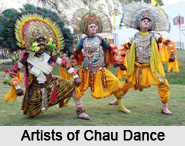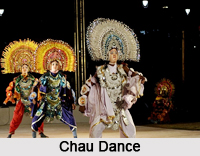 Chhau dance is a genre of Indian tribal martial dance which is well-liked in the Indian states of Odisha, Jharkhand and West Bengal. Chhau dance perhaps originated from martial dance Phari Khanda Khela. During the eighteenth and nineteenth centuries, many rulers of Odisha region took interest in the development of this art. They maintained troupes who would perform on special occasions. The word `Chhau` is derived from Sanskrit word `Chhaya` which means shadow or image. It is performed by the tribes in order to appease and influence the Sun God. Whatever is the origin of this folk drama, in course of time it has developed its own rules and grammar. Nowadays, Chhau dance is generally performed during the Chaitra Parva. Gradually this dance has shifted from the barracks and has taken a ritualistic turn.
Chhau dance is a genre of Indian tribal martial dance which is well-liked in the Indian states of Odisha, Jharkhand and West Bengal. Chhau dance perhaps originated from martial dance Phari Khanda Khela. During the eighteenth and nineteenth centuries, many rulers of Odisha region took interest in the development of this art. They maintained troupes who would perform on special occasions. The word `Chhau` is derived from Sanskrit word `Chhaya` which means shadow or image. It is performed by the tribes in order to appease and influence the Sun God. Whatever is the origin of this folk drama, in course of time it has developed its own rules and grammar. Nowadays, Chhau dance is generally performed during the Chaitra Parva. Gradually this dance has shifted from the barracks and has taken a ritualistic turn.
History of Chau Dance
Some people say that "Chau" is a dialect which means six faces: fore head, eyes, nose, cheeks, lips and chin and a mask bears the six parts of the face. The word "Chau" ordinarily means mask and because the dance is performed by use of mask, it is called "Chau Dance". According to another school of thought the word "Chau" has been derived from Sanskrit word "Chabi" that means image. Others say that as the dance is characterized by variety it is called Chau dance and therefore the word meaning of "Chau" is Chabila in Sanskrit and picturesque in English. According to new theories Chau is invented pronunciation of the word Chauni (Military Barrack or Cantonment).
 The Chau dance of Purulia is not bounded by the efforts or patronage of an individual but it is the product of the people. Certainly there was some pioneer who introduced a particular system, which is still being followed till today. Chau dance of Purulia has a very ancient origin. Orthodox Brahmins were imported from the interior of West Bengal, Bihar and Odisha. Hindu image-makers were also imported. The image-makers appointed by the Raja of Bagmundi invented the technique of making the masks for Chau dance after their settlement here.
The Chau dance of Purulia is not bounded by the efforts or patronage of an individual but it is the product of the people. Certainly there was some pioneer who introduced a particular system, which is still being followed till today. Chau dance of Purulia has a very ancient origin. Orthodox Brahmins were imported from the interior of West Bengal, Bihar and Odisha. Hindu image-makers were also imported. The image-makers appointed by the Raja of Bagmundi invented the technique of making the masks for Chau dance after their settlement here.
Themes of Chau dance
The themes of the Ramayana and the Mahabharata were introduced in the Chau dance at a later and final stage. However there is continuity of tradition from the earliest form of Chau dance of the Jain and Buddhist age to the medieval form of it. Some basic elements of the dance have been borrowed from the aboriginals and incorporated it later. However the attributes and its codification into a proper from are the contributions of sophisticated arts. Chau dance belongs to the tandava form of Indian Classical dance.
All the cultural elements possessed by the aboriginals are not their own instead some have been borrowed from superior cultures. The most important social function of the feudal chiefs was the celebration of the ceremonial worships of the goddess Durga. Along with the celebration of Durga by the feudal chiefs the story of Ramayana was introduced and it was included in the local dance-drama performance of Chhau. It may be presumed that by the eighteenth century A.D Chhau dance of Purulia adopted Ramayana as its theme. Simultaneously masks made of pulp were introduced by the image-makers of Purulia, instead of wooden masks.
In 2010 the Chau dance was marked in the UNESCO`s Representative List of the Intangible Cultural Heritage of Humanity. The Hindi film Barfi! has some scenes that features the Purulia Chau in it.



















